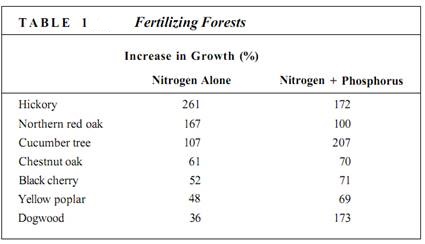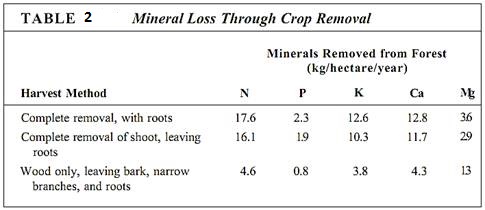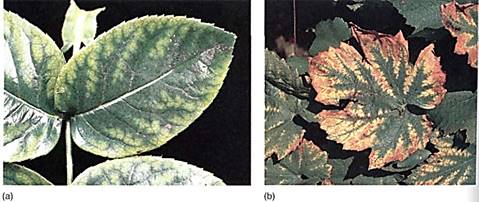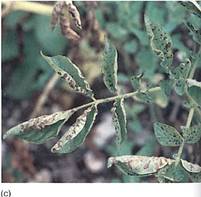


 النبات
النبات
 الحيوان
الحيوان
 الأحياء المجهرية
الأحياء المجهرية
 علم الأمراض
علم الأمراض
 التقانة الإحيائية
التقانة الإحيائية
 التقنية الحيوية المكروبية
التقنية الحيوية المكروبية
 التقنية الحياتية النانوية
التقنية الحياتية النانوية
 علم الأجنة
علم الأجنة
 الأحياء الجزيئي
الأحياء الجزيئي
 علم وظائف الأعضاء
علم وظائف الأعضاء
 الغدد
الغدد
 المضادات الحيوية
المضادات الحيوية|
Read More
Date: 30-10-2016
Date: 31-10-2016
Date: 27-10-2016
|
Mineral Deficiency Diseases
CAUSES OF DEFICIENCY DISEASES
Virtually all types of soil contain at least small amounts of all essential elements; under natural conditions it is rare to encounter plants whose growth and development are seriously disrupted by a scarcity or an excess of mineral elements. It is especially uncommon to find plants suffering from an overabundance of a particular mineral. In many cases, the unnecessary ions are not even absorbed by the roots. Certain types of excess minerals, if absorbed, can be precipitated in vacuoles as crystals; although a cell may contain large amounts of the mineral, only the ions actually in solution have any significant effect on metabolism.
Desert soils often have excessive amounts of all available minerals because ground water moves upward, carrying dissolved minerals with it. These can reach such strong concentrations that the water potential of the soil solution is extremely negative and roots are unable to extract water from it. Plants are unable to grow, not because of mineral toddy but because of osmotic drought (Fig. 1). Some species are adapted to less severely salty regions; salt bush (Atriplex) absorbs both water and salt but passes salt directly though the body and secretes it from salt glands located on leaves. This produces a coating of salt crystals that is thought to be selectively advantageous (Fig. 2). The salt reflects away some of the excessive sunlight. It also makes the bush an unacceptable food because desert-dwelling animals must avoid salty foods in order to balance their salt/water intake.

FIGURE 1:As water evaporates from the soil, more water moves upward, carrying dissolved minerals that crystallize as the water evaporates. When soil water is present, its osmotic potential is extremely negative, as is its water potential (its pressure potential is zero). Roots cannot pull water out of such osmotically dry soil; they would die before their water potential became sufficiently negative.

FIGURE 2: (a) Certain mangroves (Avicennia) of tidal marshes secrete salt through special glands. Manipulation and transport of such large amounts of salt require tremendous energy use, but sat excretion not only permits growth in saline habitats but also provides protection against herbivores. (Robert & Linda Mitchell) (b) Most plants neutralize excess salts by precipitating them as crystals such as these. (Courtesy of H. ]. Arnott, University of Texas, Arlington).
Mineral deficiency disease does not seem common in natural populations. Some soils nay have such low concentrations of certain essential elements that some species are unit to thrive on them. For example, a type of soil called serpentine soil is extremely deficient in calcium and few plants grow on it. Some species are more sensitive than others to low concentrations of essential elements (Fig. 3). Owing to competition with other pans and pathogens, the sensitive plants probably weaken and die early and do not reproduce successfully. Consequently, species especially sensitive to a particular deficiency typcallyi do not occur in the plant community growing on soil deficient in that element.
Deficiency diseases are most commonly encountered in non-native crop plants or ornamentals Crop plants especially have undergone human artificial selection (not natural ionselect) for traits such as rapid growth and high fruit/seed yield that require large marts of nitrogen and mineral nutrients. Without fertilization, these plants often have pure growth and symptoms of deficiency diseases. As shown in Table, 1, entire forests can be fertilized. The data show the results of fertilizing forests in Tennessee with 335 kg/ heatae of fixed nitrogen, either with or without phosphorus. Addition of nitrogen was beneficial, as virtually all soils are deficient in fixed nitrogen. But addition of phosphorus often did not improve tree growth more than nitrogen alone. Soils naturally contain aatequde phosphorus for many forest species.

FIGURE 3 :Beans are especially sensitive to deficiency of zinc. On soils low in zinc, many plants grow well and are healthy but leaves of beans develop white necrotic spots where the cells die. (KenWagner/Phototake).

The very act of harvesting crops leads to soil depletion: Fruits, seeds, tubers, and storage roots often have the greatest concentration of minerals in a plant. Harvesting them removes those minerals from the area; the rest of the plant body is relatively mineral-poor and does not contribute much to re-enriching the soil even if it is plowed back in. With human populations, consumption of food may occur thousands of miles from the site of plant growth; even worse, waste products are dumped into rivers and carried away, never being returned to the soils. Under natural conditions, minerals are returned in the form of manure, which is typically deposited in the general region where feeding occurs. The meet extensive crop removal is harvesting a forest for timber (Table 2). But several methods of harvesting are possible: removal of every part of the tree versus trimming and debarking, which permit the small branches, leaves, and bark to remain in the ecosystem.

SYMPTOMS OF DEFICIENCY DISEASES
The particular symptoms of a mineral deficiency are more closely related to the particular element that is lacking than to the plant species; usually all plants that suffer from a scarcity of a particular essential element show the same symptoms. One common symptom is chlorosis; leaves lack chlorophyll, tend to be yellowish, and are often brittle and papery. Deficiencies of either nitrogen or phosphorus cause another common symptom, the accumulation of anthocyanin pigments that give the leaves either a dark color or a purple hue. Alack of certain elements causes necrosis, the death of patches of tissue. The location of the necrotic spots depends on the particular element: Potassium deficiency causes leaf tips and margins to die, whereas manganese deficiency causes the leaf tissues between veins to die even though all the veins themselves remain alive and green.
MOBILE AND IMMOBILE ELEMENTS
An important diagnostic aspect is whether symptoms appear in young leaves or older leaves. This is related to the mobility of the essential element. Boron, calcium, and iron are immobile elements; once they have been incorporated into plant tissue, they remain in place. They do not return to the phloem and cannot be moved to younger parts of the plant. A plant that grows in a soil deficient in boron, calcium, or iron is probably able to grow relatively well until the few available ions have been absorbed. Growth is normal until the sol is exhausted; further growth suffers mineral deficiency, and the newly formed tissues are affected (Fig. 4a).


FIGURE 4: (a) This rose leaf is suffering from iron deficiency. Because the element is immobile, the little iron present in the plant cannot be transferred from older leaves to younger ones, so young leaves show the disease symptoms. Cells near the veins have chlorophyll; those farther away are chlorotic. (Earth Scenes; Holt Studios) (b) These mature grape leaves are suffering from a deficiency of phosphorus. Because the element is mobile, the plant can transfer atoms of phosphorus from older leaves to newer ones. (Nigel Cattlin/Earth Scenes; Holt Studios) (c) These potato leaves, suffering from manganese deficiency, have black necrotic spots. (Earth Scenes; Holt Studios(
The elements chlorine, magnesium, nitrogen, phosphorus, potassium, and sulfur are mobile elements; even after they have been incorporated into a tissue, they can be translocated to younger tissue. Once the soil becomes exhausted of one of these elements, older leaves are sacrificed by the plant. The mobile elements are salvaged and moved to growing regions (Fig. 4b). The adaptive value of this is easy to understand: A leaf photosynthesizes most efficiently right after it has first expanded and less efficiently as it ages. The plant can increase its overall photosynthetic rate by sacrificing the old, inefficient leaves and using the minerals to construct new, efficient leaves.
The immobility of certain ions is not understood; boron, calcium, and iron are initially moved upward from roots into shoots, flowers, and fruits, so transport mechanisms do exist for them. Mutations that would result in the degradation of cytochromes in old leaves and the recovery of iron should be selectively advantageous. Animals have trouble with mineral recovery as well. For example, humans do not recycle the large quantities of iron in dad red blood cells; it is simply discarded, even if this results in anemia.



|
|
|
|
تفوقت في الاختبار على الجميع.. فاكهة "خارقة" في عالم التغذية
|
|
|
|
|
|
|
أمين عام أوبك: النفط الخام والغاز الطبيعي "هبة من الله"
|
|
|
|
|
|
|
قسم شؤون المعارف ينظم دورة عن آليات عمل الفهارس الفنية للموسوعات والكتب لملاكاته
|
|
|